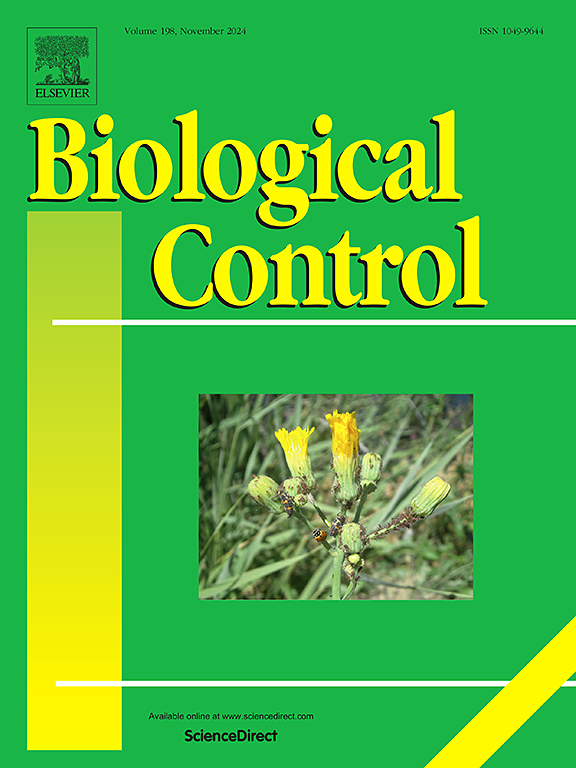开花荞麦支持日本三角霉和三角霉卵寄生在Halyomorpha halys上
IF 3.4
2区 农林科学
Q2 BIOTECHNOLOGY & APPLIED MICROBIOLOGY
引用次数: 0
摘要
行间开花植物生境管理可作为促进水果作物害虫生物防治的一种策略。本文研究了行间地膜覆盖管理对危害水果作物的主要害虫日本三尾蛾(Trissolcus japonicus)和三尾蛾(Trissolcus mitsukurii Ashmead)卵寄生蜂(膜翅目:绢叶蜂科)的保护效果。在一项为期两年的实地研究中,我们评估了猕猴桃果园中三种不同的行间地面覆盖管理下,日本夜蛾和mitsukurii夜蛾的丰度和寄生率,这些管理的特点是使用不同的开花植物:荞麦,一种以对三斑蜂有益而闻名的提供花蜜的植物;一种由十种植物组成的商业绿肥混合物,其中四种已知为寄生蜂提供花蜜,另一种是用修剪过的自然植被作为对照。结果表明,荞麦提高了外来种三色蛾(Trissolcus)对halys虫卵(天然虫卵和前哨虫卵)的寄生能力。在研究的第一年,绿肥田中也观察到对哨兵虫卵的寄生改善,但绿肥田中植物种类的多样性增加了其他种类的臭虫在猕猴桃上产卵的数量。猕猴桃蚜的有限增殖率随寄生水平的提高而降低,但不同地被覆盖方式下猕猴桃蚜的总体数量保持一致。本研究结果表明,添加开花植物,特别是荞麦,可以促进卵寄生在halys上,代表了一个潜在的策略,包括在果园的害虫综合管理策略。本文章由计算机程序翻译,如有差异,请以英文原文为准。
Flowering buckwheat supports Trissolcus japonicus and Trissolcus mitsukurii egg parasitism on Halyomorpha halys
Habitat management using inter-row flowering plants can be a strategy for the promotion of biological control of fruit crops pests. In the present study, we investigated the effect of inter-row ground cover management in supporting Trissolcus japonicus and Trissolcus mitsukurii (Ashmead) (Hymenoptera: Scelionidae), egg parasitoids of the invasive Halyomorpha halys Stål (Hemiptera: Pentatomidae), a major pest in fruit crops worldwide. In a two-year field study, we evaluated H. halys abundance and parasitism by T. japonicus and T. mitsukurii in a kiwifruit orchard in three different inter-row ground cover managements characterized by the use of different flowering plants: buckwheat, a nectar-providing plant known for its beneficial effect on Trissolcus wasps; a commercial green manure mixture of ten plant species, four of them known to provide nectar for parasitoids and a control with mowed spontaneous vegetation. The results showed that buckwheat improves the parasitism of adventives Trissolcus on H. halys eggs (on both natural and sentinel eggs). An improved parasitism on sentinel egg masses was also observed in green manure during the first year of the study, but the greater diversity of plant species in green manure plots caused an increase of egg masses laid on kiwifruit by other stink bugs species. Although the finite rate of increase of H. halys population decreased with higher levels of Trissolcus parasitism, the overall pest population on kiwifruit remained consistent across different ground cover managements. The results obtained here highlighted that adding flowering plants, in particular buckwheat, can promote egg parasitism on H. halys and represent a potential tactic to be included in integrated management strategies of this pest in fruit orchards.
求助全文
通过发布文献求助,成功后即可免费获取论文全文。
去求助
来源期刊

Biological Control
生物-昆虫学
CiteScore
7.40
自引率
7.10%
发文量
220
审稿时长
63 days
期刊介绍:
Biological control is an environmentally sound and effective means of reducing or mitigating pests and pest effects through the use of natural enemies. The aim of Biological Control is to promote this science and technology through publication of original research articles and reviews of research and theory. The journal devotes a section to reports on biotechnologies dealing with the elucidation and use of genes or gene products for the enhancement of biological control agents.
The journal encompasses biological control of viral, microbial, nematode, insect, mite, weed, and vertebrate pests in agriculture, aquatic, forest, natural resource, stored product, and urban environments. Biological control of arthropod pests of human and domestic animals is also included. Ecological, molecular, and biotechnological approaches to the understanding of biological control are welcome.
 求助内容:
求助内容: 应助结果提醒方式:
应助结果提醒方式:


